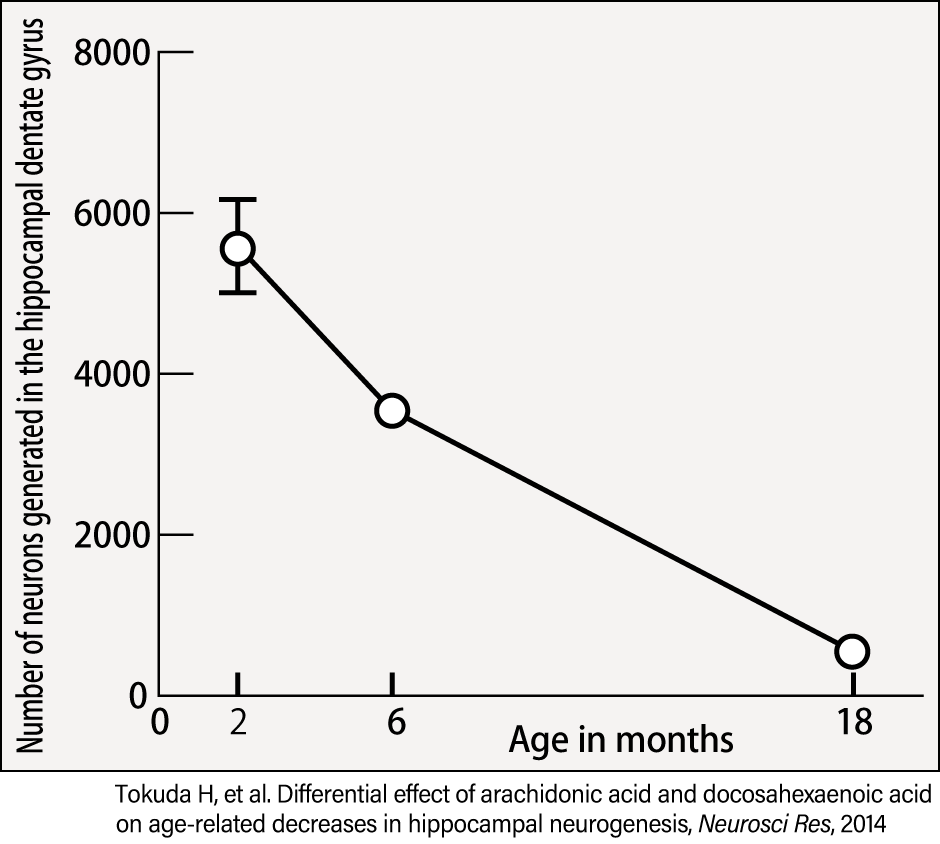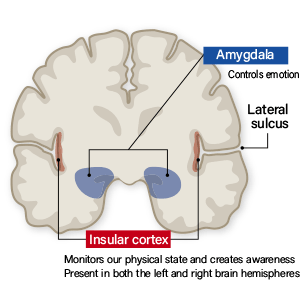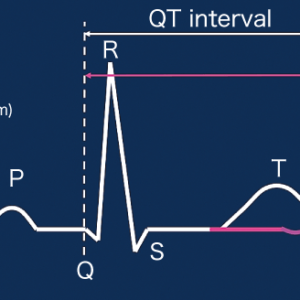It was long believed that neurons were not produced in the brain past the early developmental stages. However, the 2000s saw the discovery that neurons are generated even in adults. Since then, the increasing number of researchers have been investigating links to PTSD and other mental illnesses, gradually shedding light on adult neurogenesis and its close relationship to the body and mind. One could even say that physical health significantly affects neurogenesis, which might offer a ray of hope for combating dementia. Moderate exercise, diet, sleep, and relaxation are crucial.
Special Feature 1 – Brain, Body, and Mind Adult neurogenesis and its relationship to physical and mental health
composition by Rie Iizuka
Humans are created from just a single fertilized egg, and by the time we reach adulthood, our bodies will have made around 37 trillion cells, including 80–100 billion brain cells. The brain cells can be broadly classified into two kinds: neurons, which transmit nerve signals, and the glial cells that surround them.
Neurons are formed from the division of neural stem cells; the process is called “neurogenesis”. The neural stem cells are produced in large quantities at a very early point in the embryonic stage, when the brain is formed. These neural stem cells then asymmetrically divide into two, with one forming another neural stem cell and the other becoming a neuron. Production of glial cells follows that of neurons in the cerebrum, i.e., the largest part of the human brain. Among the various brain cells, neurons are the cells involved in transmitting information.
New neurons are formed in the adult hippocampus
As can be seen from the persistence of the “myth of the first three years,” which holds that the human brain is entirely formed in the first three years of life, it was long believed that neurons were not generated in the brain after the early developmental stages. This theory was propounded in a 1926 paper by the Spanish neuroanatomist Santiago Ramón y Cajal. It is true that neurons basically decline as we age. However, the process of adult neurogenesis in the brain has become the focus of attention since the 2000s.
It was originally discovered by a research team led by Joseph Altman of the U.S. As a result of research on rats in the 1960s, they ascertained that new neurons are generated in the hippocampus and olfactory bulb (the part of the brain involved in processing information about smells). However, at the time, the prevailing “common knowledge” was that, while adult neurogenesis might be able to occur in rats and other lower animals, it was impossible in humans. There may also have been a reluctance to challenge such a prestigious scientist and Nobel Laureate as Cajal, who had laid the foundation of modern neuroscience. At any rate, at the time of his publication on neurogenesis, Altman’s research was disregarded.
In the mid-1980s, a study concerning neurogenesis in songbirds caused a stir. Songbird can learn a new song for each reproductive season, and a team led by Fernando Nottebohm of the Rockefeller University in the U.S. revealed that in the songbirds, neurons were generated in the part of the brain associated with learning songs. Consequently, Altman’s research into neurogenesis and learning at last made it into the light.
Toward the end of the 1990s, proof of adult neurogenesis in humans was finally found. With the cooperation of cancer patients with an informed consent, a study was carried out in which the patients were injected with a drug that can mark newly generated cells and their brains were studied after their deaths. As a result, the presence of newly generated cells in the brain was discovered.
Subsequent research found that neurogenesis in humans occurs in the hippocampus and in the striatum of the basal ganglia, with the extent of which not all researchers agreed. As the hippocampus is known to be the area of the brain involved in memory and cognition, the topic of neurogenesis attracted considerable attention (Figure 1).

Figure 1. Hippocampal atrophyThe image on the left shows a healthy individual. In the Alzheimer’s patient (right), hippocampal atrophy can be seen (arrow) with a decrease in neurons. In other words, neurogenesis holds out tremendous hope for sufferers of dementia and similar conditions.
Tests on rats showed that the presence of “fresh” neurons in the hippocampus when learning something new serves to build new neural circuits, thereby promoting its committal to memory. Conversely, if neurogenesis is inhibited, the achievement of learning tasks (remembering) becomes more difficult and exercise capacity declines. The number of newly generated neurons dwindles with growth and age (Figure 2), so as other cells within the body.

Figure 2. Rat age and number of hippocampal neurons generatedThe number of neurons generated declines with growth and age in rats.
Neurogenesis is also related to mental illness
At the end of their nymphal stage, cicadas make their way above ground, chirp frequently to alert females to their presence, and then reproduce before dying. Such creatures with a short life span have no need to learn anything during their lives, and their preinstalled neural programs are probably sufficient for them to survive the struggle for existence. However, for animals with longer life expectancies, these mechanisms are unlikely to be adequate. What humans and other long-lived animals learn by the age of three is entirely insufficient and they need to learn new things to adapt to changes in their environment. Generating new neurons is therefore vital in order to remember new things.
Many subsequent studies have taught us not only that the neurogenesis is related to memory and learning, but also that its decline is connected to mental illnesses such as depression and post-traumatic stress disorder (PTSD).
After publishing his first study on adult neurogenesis, Altman, too, studied the effects of “enriched environment” on neurogenesis; rats were exposed to a good environment–that is to say, a stress-free environment with a spacious cage in which they could play happily on their wheel to their heart’s content. Later researchers revealed the existence of a link between stress and neurogenesis.
Conversely, when rats were exposed to intense stress in an experimental setting, they exhibit a depressive state in which they crouch motionless in a corner of their cage. Neurogenesis declined when this occurred. Then, researchers found that when the rats were administered antidepressants, their depressive symptoms disappeared and, at the same time, new neurons were produced in the hippocampus. In 2009, a team led by Professor Kaoru Inokuchi (now at the University of Toyama) published an article suggesting a link between neurogenesis and PTSD.
In rodents, the hippocampus stores “short-term memories” from a few days to a month or so (in humans, the period is a few weeks to a few months). The team Inokuchi found that when new neurons were generated, connections between the existing cells in the hippocampus were rendered unstable, causing older memories to fade. On the other hand, when neurogenesis was inhibited, old memories remained in the hippocampus. After being stored in the hippocampus for a certain period, memories are stored in a particular part of the brain, becoming “long-term memories”. Professor Inokuchi’s article posited that the brain’s failure to carry out this process appropriately could be a factor in PTSD.
Neurogenesis declines not only with intense stress, but also with age, as described above. One of the symptoms of dementia is impaired spatial and temporal memory, leading to sufferers being unable to remember where they put their wallet or how to find their way back home. Such symptoms could be a reason why sufferers might experience low mood. Here, the decline in neurogenesis in the brain itself is one of the risk factors to cause symptoms such as dementia and depression.
Even brain cells are daily generated and replaced
As we cannot see the mind, how do we know where it is located? While this is a tricky question, my standing point as a biologist is that the brain creates the mind, including at the level of the unconscious.
I see the brain as something organic. I am interested in the processes that change during the time, for example, few weeks to months, during which neurons are generated from neural stem cells and incorporated into new circuits, along with the longer time scale of brain development and evolution. A key point in this is the fact that the brain is not something solid and static like a computer, as can be seen from the example of neurogenesis.
As described above, new neurons are generated throughout our long human lives. In addition, the phospholipids forming the neuronal cell membrane are routinely replaced. If we compare cells to pieces of brick building a house, the old bricks are replaced with new ones day by day, while the house maintains its structure in the original shape. Just like in the other parts of the body, the cells in our brain also generated and replaced every day. In other words, they are lively changing.
On the other hand, there are many studies that consider the brain as a relatively inorganic structure like a computer. Some researchers think the function of the brain as a program that runs on a computer. We can now see the moment when the electrical signals are transmitted in the brain, and even change our mood by stimulating specific areas. The ability to elicit a desired reaction by pressing a “switch” in this way has resulted in a particular upsurge in research focused on brain functions, including consideration of treatments for a variety of diseases.
However, to avoid misunderstanding, I want to emphasize that it is not only the brain that influences our mental state. The workings of our autonomic nervous system cause our heart rate to rise and fall, the quantity of saliva we secrete to change, and our bowel function to become sensitive or insensitive. I believe these reactions may also be an underlying layer that contributes to our mental state. It is easy to imagine how, when we are touched with a warm hand, signals are transmitted by our sensory nerves and something changes at some level in our brain, eliciting the reaction “feel good.”
The pleasant feelings we get from a massage, the supreme happiness of snuggling down under a warm comforter, the soothing experience of having a cat curled up on one’s lap…all these are examples of physical factors that significantly influence our mental state.
When people are engaged in physical activity together, one sometimes observes their movements becoming synchronized, as though they had converged on the same wavelength. The Balinese Kecak dance is an easily understood example of this phenomenon. As the dancers move their bodies while listening to the rhythm of the music, their breathing becomes synchronized, causing a change in the mental state of the whole group.
I believe that the body, brain, and mind are so closely linked as to be inseparable, and that understanding the brain alone is not enough to understand the mind.
I have talked about the brain and mind from the physical perspective of adult neurogenesis. Neurogenesis is an essential element in maintaining physical as well as mental health. Fortunately, we know there is one thing that definitely has a neurogenerative effect: exercise. Since Altman’s time, studies have found that inhibiting neurogenesis causes mild ataxia and decreased performance in the water maze task designed to measure spatial learning. Researchers around the world have subsequently shown that exercise improves neurogenesis.
In 2011, a team led by researchers from the University of Pittsburgh in the U.S. conducted a study of 120 men and women aged between 55 and 80, who led a sedentary lifestyle and did not have dementia. The subjects were divided into two groups —— one that engaged in aerobic exercise (walking) for 40 minutes per day for three days a week and one that did only stretching —— and the condition of each subject’s hippocampus was investigated afterward.
The brain has been observed to atrophy with age, but if we focus on the hippocampus, we can see evidence that exercise ameliorate the degree of atrophy. While the mechanism has not been fully uncovered, my view is that there is a link to improved blood flow as a result of exercise.

Figure 3. Neurogenesis resulting from exerciseThis graph shows the increase in hippocampal volume among the aerobic exercise group (blue line) and reduction in hippocampal volume among the stretching group (red line) for both left and right hippocampi. The volume increases proportional to the period for which the exercise is continued.
The brain has been observed to atrophy with age, but if we focus on the hippocampus, we can see evidence that exercise affects the degree of atrophy. While the mechanism has not been fully uncovered, my view is that there is a link to improved blood flow as a result of exercise.
The essentials for brain health
Diet also contributes to the health of our neurons. Our research in rats has revealed that a fatty acid called arachidonic acid assists in neurogenesis. When it comes to nutrition, one can never say this food is ideal, or that balance in meals is perfect. However, what we can say is that a monotonous diet or a diet skewed toward only certain nutrients is undesirable. Having said that, diets backed by evidence of their promoting longevity —— such as the Mediterranean diet or traditional Japanese cuisine —— are likely to be good for the brain as well.
And then, there is sleep. People say that one sleeps less deeply as one gets older. In fact, this too has been shown to be related to neurogenesis. Sleep not only enables the body to rest, but also plays a part in selection and organization of memories stored in the brain. The brain sorts which memories should be retained, and which discarded, strengthening the former and deleting those no longer needed. Unnecessary memories can sometimes cause ill-health. As repeatedly remembering painful memories of a disaster or other experience can cause PTSD and other mental illness, an appropriate degree of forgetting is required. The appropriate exercise, diet, and sleep deemed necessary to enjoy a healthy life are also essential to the health of our brain.
One area on which I wish to focus in due course is sex-based differences in brain diseases. There are known to be certain differences, such as that depression is more common in females, while autism is more often found in boys. Our current understanding is that such mental disorders might be caused by a slight discrepancy (like buttoning up incorrectly) in genes at the developmental stages. Investigating this will enable us to pose such questions as “How do brains capable of reading maps differ from those that cannot?” and “At what stage in the brain’s development do differences in gender identity emerge?,” rather than thinking in terms of “male brains” and “female brains.” I believe that these diverse approaches will also shine a light on the mind.




















